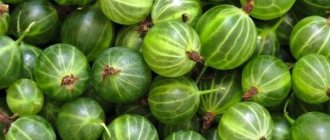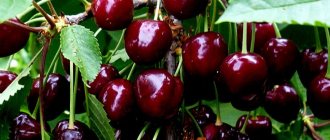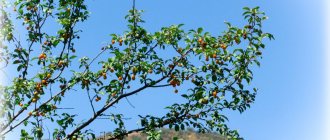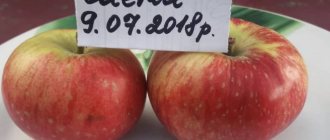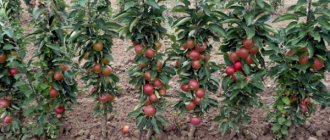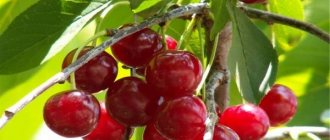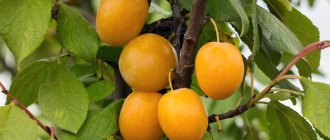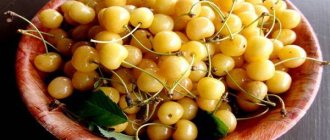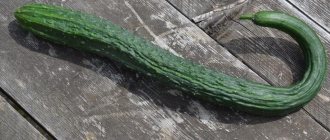Planting cherries in the Moscow region
Since cherries are considered a southern plant, the most important task is to provide the trees with sufficient lighting, protect them from the north wind and create comfortable humidity for the root system. Therefore, planting cherries in the Moscow region is most often done on the south side of a fence or building. You should also avoid shading the crown by planting other trees at a sufficient distance.
When to plant cherries?
If you buy seedlings with a closed root system, you can plant such specimens in open ground at any time. Sweet cherries prefer neutral soil, so garden soil that does not require alkalization or oxidation is quite suitable for planting. If you have planting material with an open root system, it is better to plant in the spring, in a planting hole already prepared in the fall with nutritious soil.
Suitable varieties for the Moscow region
Cherries are distinguished from cherries and other fruit trees by their demanding nature and high sensitivity to low temperatures. Therefore, varieties with good frost resistance are selected for planting in the Moscow region and other regions with a temperate climate. Even for zoned varieties, spring and autumn frosts are dangerous. To obtain good harvests, cherries should be planted in areas with fertile soil, well-lit by the sun and protected from the cold wind. Therefore, when creating new varieties, emphasis is placed on adaptability to cold climates and plant endurance.
Valery Chkalov
Cherry seedlings of this variety grow to a height of 6 m. The plants produce large fruits in the shape of a wide heart with a blunt apex. The skin of the fruit is dark red to dark burgundy in color and the flesh of the same color has a pleasant taste. They are eaten fresh, canned, and used for winter preparations. The trees tolerate winter temperature drops down to -30°C well. For good fruiting, plants need protection from coccomycosis and gray rot. The following varieties are suitable for pollinating the variety:
- Jaboulet;
- Bigarro;
- April;
- Skorospelka;
- June early.
Why don’t cherries bear fruit and what to do about it?
The cherry tree begins to bear fruit 4-5 years after planting. It happens that seedlings do not bear fruit - what could be the reason?
There are several factors why cherries do not bear fruit:
— pests
Aphids, leaf beetles and other insects can greatly harm the plant and cause crop loss.
— unsuitable soil.
Cherry prefers neutral fertile soil.
— bad location.
As we have already said, the plant needs a sunny area protected from the wind.
— pruning
Too thick a crown is not typical for cherries - it is very important to prune the seedlings in a timely manner.
— diseases.
Fungal, bacterial, and viral diseases can also ruin your harvests.
— lack of fertilizing.
For abundant and high-quality fruiting, you need to apply fertilizers rich in microelements at least twice a year.
— lack of pollinator.
Perhaps the variety you planted is self-sterile. Such cherries require cross-pollination.
Let's look at the last point in more detail. After all, when the cherry tree is healthy, not damaged, blooms beautifully, but still does not bear fruit, the lack of a pollinator is the most common reason. There are self-fertile, partially self-fertile and self-sterile varieties of cherries. The first category includes varieties that do not need additional pollination; representatives of the second category can bear fruit alone, but the harvests will be rare and meager; varieties from the third category are not able to bear fruit without pollinating neighbors. If in the first case even one tree will delight you with high-quality harvests, then in the other cases it is necessary to plant several varieties of cherries on the plot at once.
The best varieties with descriptions and photos
Below we list the best varieties of cherries for the Moscow region.
Lena
The late-ripening variety "Lena" has been under variety testing since 2006. The medium-sized tree has a standard round-oval crown. The variety needs pollinators. Recommended varieties are Iput, Revna, Ovstuzhenka. The tree begins to bear fruit in the 4th year.
“Lena” has large, dark red fruits, weighing from 6 to 8 g. Ripe cherries turn black and red. The variety is practically free from coccomycosis, moniliosis, and clusterosporiasis. Tasting score – 4.7 out of 5 possible. The average yield of the variety is 80 c/ha. This variety is chosen because of its large, tasty fruits, high yield and frost resistance.
Michurinskaya (Michurinka)
Late-ripening cherries bred by breeders of the All-Russia Research Institute named after. Michurina. In variety testing since 1994. A medium-sized tree characterized by rapid growth has a raised, round-oval crown. The tree produces its first fruits in the 5th-6th year.
Dark red drupes weigh about 6-7 g. The fruits have short stalks that are easily separated from the branches. The variety is versatile and transports well. From 80 to 140 centners are collected from 1 hectare. The variety needs pollinators. Recommended pollinator – Pink pearl. The variety is recommended for the Moscow region - it is frost-resistant, drought-resistant, and does not suffer from coccomycosis. The disadvantage of this variety is that the wood can be damaged by frost, and because of this the tree is short-lived.
Veda
Late-ripening sweet cherry of domestic selection. Recommended for the Central region. The tree is not tall - about 2.5 m. At this height, the tree is convenient to care for and harvest. The crown is rounded and wide. Recommended pollinators are Bryanochka, Tyutchevka, Bryansk pink.
The fruits are deep red, almost black. They weigh about 5-6 g. The pulp is dark red, the juice is burgundy. Productivity – 77-80 c/ha. One tree grows from 25 to 65 kg of cherries. It transports well, so the variety is good for commercial cultivation. "Veda" attracts gardeners in the Moscow region with its high frost resistance, sweetness and versatility of its fruits. Experts gave the variety a tasting score of 4.6 points. Drought resistance is average, and winter hardiness is high. After the harshest winters, flower buds are preserved by 80%.
From a botanical point of view, a cherry is a fruit, a drupe; from a culinary and household point of view, it is a berry.
Raditsa
An early variety of domestic selection, included in the State Register in 2001. The tree grows quickly, has an average height of up to 4 m, and a medium-dense crown. Needs pollination. Recommended varieties are Iput, Revna, Tyutchevka. The harvest appears in 4-5 years. About 60 c/ha are collected from 1 hectare.
The drupes are slightly elongated and dark red. Ripening fruits turn black. The pulp and juice are dark red. One drupe weighs an average of 4.5 g. The maximum weight is 6 g. The stalks are long and thin. Tasting score – 4.5 points. The stalks are easily torn from the branches - easy to harvest. Withstands frosts down to minus 35 degrees. Does not suffer from coccomycosis and moniliosis. The fruits do not crack.
And the way
Early ripe cherry. The height of the tree is 4 m. It has a wide pyramidal crown. Although the variety is early, in the Moscow region it ripens only at the end of June. One tree produces 25-50 kg of fruit. The best pollinators are Revna, Tyutchevka.
The color of cherries changes as they ripen - from red to black. Weight – 5-5.5 g. Maximum weight – 9 g. Easily detached from the stalks. Very juicy and sweet pulp. Tasting score – 4.5. Disadvantages - they crack during rains, the seeds are difficult to separate, they are demanding on soils. Pros: resistance to fungus, frost resistance, versatility, ability to transport, shelf life.
Rechitsa
The variety is classified as mid-season. The tree quickly grows to 3-4 m. The crown is pyramidal. Ripens in the second half of July. 80 centners are collected from 1 hectare, maximum – 140 centners. One tree produces about 30 kg of fruit. Recommended pollinator – Iput. The tree bears fruit in the 5th year.
The drupes are round, deep red, to black. They weigh 5-6 g. The juice and pulp are red. The berries taste sweet, the rating score is 4.5. During transportation, juice does not flow from the fruits - cherries can be transported without loss. The fruits are universal - tasty fresh and good in preparations. Drought resistance is average, and frost resistance is high. The variety is resistant to return frosts.
Bryansk pink
This variety was bred recently, but has already become popular among gardeners. If you follow agricultural technology, Bryansk pink bears fruit well in the Moscow region. In the Central region it was zoned in 1993. Late variety. The tree has a wide pyramidal crown. Pollinators – Iput, Revna, Ovstuzhenka. On one tree - 20-30 kg of cherries.
The drupes are round and pink. There is a speckled pattern on the skin. Weight – 4-5.5 cm. The pulp is yellow, with characteristic cartilage. The juice is clear and colorless. The taste was rated 4.1 points by tasters. The variety is valued for its berries - very beautiful and tasty, winter hardiness, resistance to fungal diseases. The fruits do not crack. The tree grows slowly, bearing fruit in the 5th year. The fruits are easily torn off with the stalks.
Stores well in the refrigerator - up to 2 weeks. The purpose is universal. The tree withstands spring frosts, the trunk is resistant to sunburn. High immunity to moniliosis and coccomycosis.
Ovstuzhenka
A variety with early-medium ripening. In the State Register of the Central Region since 2001. The trees grow small in height. The growth rate is high. The crown is medium-dense, spherical, slightly raised. The first fruits appear at 4-5 years. Up to 16 kg of cherries are removed from the tree. Very low self-pollination - only 5%. Pollinators – Iput, Raditsa, Revna, Bryansk pink, Tyutchevka.
The fruits are large - from 4 to 6 g. The oval-rounded fruits are dark red in color and turn black as they ripen. Do not crack even in high humidity. The berries are extremely sweet. Evaluation score – 4.7. The variety is very resistant to fungal diseases. Gardeners in Ovstuzhenka are attracted by the aesthetics and taste of the fruit, the compactness and short stature of the trees, the yield and immunity to disease.
Odrinka
From mid-late varieties. The variety is relatively new - it was included in the register for the Central region in 2004. The trees are medium-sized, with a medium-dense crown. It begins to bear fruit in the 5th year. Pollinators – Rechitsa, Ovstuzhenka, Revna. From 1 hectare they collect from 80 centners. Maximum yield – 220 c.
The fruits weigh from 5.5 to 7.5 g. The rounded, dark red drupes have dense red flesh. Taste rating: 4.7 points. The standard withstands extreme conditions - sun and frost. Frost resistance – down to minus 34°C.
People's Syubarova
Unlike most cherry varieties, Narodnaya Syubarova is a self-fertile variety. Self-pollination is about 90%. Bred by Belarusian breeders. The tree is powerful, tall - 5-6 m, with a very wide crown. One tree grows up to 55 kg of cherries. The first harvest is 4 years after planting the tree.
The berries are dark scarlet in color, with glossy skin. One fruit weighs about 6 g. The variety withstands frost and strong winds. The branches are powerful and can withstand heavy snow loads. The variety is generally unpretentious to soils. Differs in friendly maturation. Innate immunity to coccomycosis and other fungal diseases.
Chermashnaya
A relatively new, yellow-fruited variety. In the State Register - since 2004. Zoned in the Central region. The trees are powerful, medium-sized, up to 5 m high. The crown is round-oval, slightly raised. The first harvest is for 4-5 years. On young trees 7 years old, up to 12 kg of cherries ripen. On mature trees – 30 kg. Productivity – 85 c/ha. Requires pollinators.
The fruits are yellow, with a pink blush, weighing 4.4 g. The fruits are not large, but there are a lot of them. The fruit has dense flesh, juicy and tender. The berries taste sweet and sour. The variety belongs to the dessert variety. Evaluation score – 4.4. Winter hardiness of the buds is average. General winter hardiness is good. High immunity to fungal diseases. Disadvantage: short storage.
Teremoshka
A variety with medium ripening periods. Weak trees have a broadly rounded crown. Desirable pollinators are Bryansk pink, Ovstuzhenka. From 1 hectare they collect from 50 to 100 centners.
The fruits are dark red, weight - 5-6.5 g. The fruits are sweet, rated at 4.7 points on a tasting scale. Cherries hardly crack in wet weather. Frost resistance – down to minus 34°C. High resistance to fungi. The fruits are dense and transport well.
Leningradskaya black
Mid-season variety. One of the first winter-hardy varieties of cherries - it is grown even in the Non-Black Earth Region and in the north of the Central Black Earth Zone. A medium-sized tree with a spreading crown. 30-40 kg of cherries are collected from a tree. The height of the tree is 3-4 m. It begins to bear fruit in the 3rd year. Harvesting – second ten days of July. The variety is self-sterile; pollinators are recommended - Iput, Revna, Veda.
The fruits are sweet, black and red. Weight – 3-3.5 g. The taste is traditional, cherry, sweet to the point of cloying, with a slight sourness. When ripe, they do not fall off for a long time. The fruits are medium and large. The pulp is dense and fibrous. Tasting score – 4.2 points.
Homestead yellow
Early table variety. Self-fertile. The tree grows quickly, but begins to bear fruit only in the 6th year. The variety has been zoned in the Central region since 1998.
The fruits are yellow, large, round, weight - 5.5 g. The pulp is cartilaginous, juicy, with colorless juice. The taste is sweet and sour. Score – 4.7 points. The berries are beautiful and do not crack in the rain. The buds are resistant to spring frosts.
Fatezh
This mid-season variety was included in the State Register in 2001. The variety is zoned in the Central region. Trees are of medium height - 3-5 m. Crowns are spherical. Harvest - for 4-5 years. 50 kg of cherries are collected from a tree, 300 kg from 1 hectare. Pollinators – Revna, Raditsa, Ovstuzhenka, Chermashnaya.
The drupes are medium-large, round. Color – red-yellow. With light pink flesh, juicy, dense, gristly. Weight – 6 g. Taste rating – 4.7 points. The fruit is torn dry from the stalk. Winter hardiness is above average. Buds, compared to branches and trunk, are less frost-resistant. Resistance to fungal diseases. The downside is the tendency to become gumy.
Valery Chkalov
This early cherry has long been known to gardeners. The variety was bred in the 50s of the last century. The tree is distinguished by its tall growth - reaches 6 m, and a thick trunk. It has a wide-pyramidal, medium-dense crown. Early maturity is average - fruiting begins by the 5th year. Optimal pollinators are Aprilka, June early, Skorospelka. About 60 kg of cherries grow on a tree. There are super-yielding trees from which up to 170 kg of berries are harvested.
The fruits are large, reaching a weight of 6-8 g. The color is dark red. As the cherry ripens, it becomes almost black. The stalk is firmly attached to the drupe. When the stalk is torn off, the fruit releases juice. The semi-cartilaginous flesh is dark red in color and has pink veins. The berries have a very good dessert taste. This variety is ideal for canning - it produces very tasty compotes. Frost resistance is at an average level - up to minus 23 degrees. During frosts, the flower buds freeze slightly - up to 60-70% die. The variety is affected by coccomycosis and gray mold. The variety is relatively resistant to other fungal diseases. This variety attracts with tasty large fruits, early ripening and abundant harvests.
Tyutchevka
This late variety has very weak self-pollinating abilities - no more than 6%. Desirable pollinators are Ovstuzhenka, Iput, Revna. It is characterized by high productivity - the trees are medium-sized, fast-growing, with spherical spreading crowns. By the 5th year of planting - the first berries.
The dark red fruits have dense, cartilaginous flesh. Average weight - 5.3 g. The tree can withstand frosts down to minus 25 °C - without shelter, with shelter - down to minus 35 °C. Very good taste characteristics. The tasters' rating was almost maximum - 4.9 points. Pros: Stores and transports well. The downside is that it is afraid of humidity; when over-moistened, the cherries crack. The drupes are torn dry from the stalks. It has exceptional resistance to moniliosis and average resistance to other diseases.
Red hill
This early table variety was bred in 2001. The variety is early-bearing - the first fruits appear in the 4th year of planting. One tree produces up to 45 kg of cherries. The trees at Krasnaya Gorka are low, with a wide, rounded crown. Berry picking time is mid-July. This is a self-sterile variety; it needs pollinators - Ovstuzhenka, Raditsa or Bryansk pink. Peak productivity is from 6 to 12 years. But by the age of 16 he becomes old, the yield drops sharply, and the tree is discarded due to its age.
The fruits are round, collected in bunches, hanging densely on the branches. The taste is sweetish, slight sourness. Color – golden, with a scarlet blush. The weight of one fruit is 4-6 g. Transportability is satisfactory. Cherries are soft and juicy; transportation requires refrigerators and special containers. The variety is quite winter-hardy.
Gronkavaya
An early, fast-growing variety. Ripening - end of June. Year of breeding: 1999. The first cherries appear in the 4th year. Self-sterile variety. Cherries Narodnaya, Krasavitsa, Iput, and Zhurba are used as pollinators. Productivity – 200 centners per 1 ha. About 30 kg are collected from the tree. Tree height is 4-5 m.
The fruits are heart-shaped, dark red, weigh on average 4.6 g. The stalk comes off without releasing juice. The seeds are small and easily come away from the pulp. Taster rating: 4.8 points. Resistant to coccomycosis and moniliosis. Sweet cherries are suitable for long-term transportation. High resistance to drought. Frost resistance is high - up to minus 27 ° C.
Revna
Mid-late sweet cherry - ripening occurs at the end of June. It begins to bear fruit only in the 5th year. The trees are medium-sized, fast-growing, with pyramidal crowns. 14-30 kg of cherries grow on a tree. From 75 to 115 centners are collected from 1 hectare. They pollinate with cherry varieties Raditsa, Ovstuzhenka, Venyaminova.
The dark red, almost black fruits weigh 5-8 g. This beautiful, juicy and sweet cherry is rated 4.9 points by tasters. The stalk comes off dry, without releasing juice. The variety is resistant to frost, fungal diseases and fruit cracking.
Orlovskaya pink
A dessert variety with an average ripening period - in mid-July. The height of the tree is 3.5 m. The crown is pyramidal, flat and raised. Early ripening - bears fruit in the 3rd year. From 70 to 110 centners are collected from 1 hectare.
The weight of round, pink cherries is about 4 g. The pulp is pink, medium-dense, juicy, sweet and sour. Taster rating: 4.4 points. Relative resistance to fungal diseases. The level of winter hardiness is average.
Gift for Stepanov
A completely new, mid-late variety - included in the State Register only in 2015. The fruits ripen by mid-July. The tree grows up to 3.5 m. The crown is pyramidal. The harvest appears in the 4th year. On 1 hectare it grows up to 80 centners. On a tree - up to 60 kg.
The dark red fruits weigh about 4 g. There are no subcutaneous points. The berries taste sweet, taster rating is 4.9. Thin stalks are easily separated from the shoots. The fruits are prone to shedding, so they are collected immediately after ripening. Sweet cherries are suitable for canned food and desserts, and are tasty fresh. Drought resistant. Transportability is limited - the fruits have thin skin and easily release juice.
Self-sterile varieties of cherries that do not bear fruit without the help of pollen from neighboring trees and bees:
—
—
—
—
If your cherry blossoms but still does not bear fruit, you may have purchased a self-sterile variety. In this case, the right decision would be to purchase one or more cherries for your garden. The more varieties you have, the more harvest you will have.
It is not so difficult to choose a pollinator for cherries. You just need to plant a variety nearby that blooms at the same time as your tree. And the bees and the wind will help pollinate the cherries.
General recommendations for those who decide to grow cherries
- 1. Cherries love the sun.
- 2. Cherries love light soils.
- 3. Likes to drink in moderation (some varieties are more drought-resistant).
- 4. Feeding – basic in spring and autumn.
- 5. Like all fruit trees, cherries need lime when planting.
- 6. Doesn't like drafts.
- 7. Like all fruit trees, it does not like high groundwater.
- 8. Winter hardiness of cherries is above average. During the first 2 winters, I wrap the planted 3-year-old seedlings with spunbond.
- 9. Some varieties of cherries have a tendency to thicken the crown and have poor resistance to diseases, so formative pruning and preventative treatments are necessary.
- 10. Pollination is a problematic issue for almost all varieties of cherries; it must be taken into account.
Cherry care
In order for your cherries to feel good, delight you with their decorative appearance and bear tasty fruits, you need to take a responsible approach not only to planting the seedling, but also to its further care. What does a tree need for successful growth and development? Timely watering, pruning, periodic feeding, prevention from diseases and pests.
Cherry pruning
Timely pruning of cherries:
- increases tree productivity
- Helps develop immunity to temperature changes
– reduces the risk of diseases and pests
- promotes proper crown formation.
Formative and sanitary pruning of cherries, like all stone fruits, is carried out in the spring before the sap flows and the buds begin to swell (usually from mid-March to the first week of April).
General pruning recommendations:
- Before pruning, we inspect the tree. We identify dimly lit and poorly ventilated places inside the crown, remove diseased and poorly developed shoots. If the branches cross, cut off the weaker branch.
— it is necessary to cut off the cherry branches at the base, in the middle of the ring influx.
— stumps should not be left, as over time they begin to rot and the tree may soon die.
- a heavy and thick branch can be cut in several stages, sawing off the main part of the tree and removing the remaining stump.
- After pruning, it is necessary to disinfect the sections.
Watering, fertilizing, prevention of diseases and pests
Cherry requires, although not abundant, regular watering, since it is a moisture-loving plant. For rapid growth and development, the tree is watered in the spring - after wintering and before fruiting. If the summer is dry, watering should be increased, but not more than once a week. During fruiting, watering is stopped to prevent the fruits from cracking. It is very important to moisten the root system abundantly before wintering in order to increase the resistance of the cherry to frost.
Cherries are usually fed twice a season. In the spring, nitrogen-containing fertilizers are applied to speed up the recovery of the seedling after winter, and in the fall, mainly phosphorus-potassium fertilizers are applied.
Preventative treatment of plants against diseases and pests is carried out in the spring before buds open. You will find detailed information and recommendations for treatments in our article.
At other times, spraying of cherries is carried out only after detection of a specific disease or pest. Also, to increase the resistance of a young seedling to unfavorable climatic conditions, it can be sprayed with bioregulators, for example, Epin or Zircon.
Cherries are not only tasty, but also a healthy fruit crop that should be in every garden.
The pulp of the fruit contains about 10% sugars, fiber, various organic acids, vitamins B, PP, C, essential oils, iron salts and a host of other substances that are incredibly beneficial for the body. By following the above rules for planting and further caring for seedlings, even a novice gardener will not have any difficulties in growing this wonderful crop.
Cherry: main diseases of the crop
Sweet cherries have fewer diseases than other stone fruits, but the main diseases of the crop are coccomycosis and sweet cherry moniliosis.
Moniliosis occurs when plants are infected with pathogenic fungi Monilla cinerea. When the disease spreads on a cherry tree, the branches and leaves dry out, as well as the fruits rot. The infection quickly spreads throughout the tree crown, especially with dense plantings in low and damp places. Cool weather and frequent precipitation contribute to the disease.
Treat your garden against pests
Coccomycosis - infection with the fungus Coccomyces hiemalis appears on leaf blades in the form of merging spots of small red dots. The infection affects plants during inclement weather. The leaves become infected and gradually turn brown and fall off.
To combat infections, plants are treated with Horus at the rate of 30 g per bucket of water.
Advice! Soap should be added to the drug solution to form a thick foam. Spraying begins from the inside of the leaves.
Affected parts of diseased plants should be burned to prevent the spread of infections.
Of all the pests, the most harmful to cherries is aphids; pest control is carried out using special preparations.
Winter-resistant varieties for the Moscow region
It is necessary to select winter-hardy cherries for the Moscow region that can withstand severe frosts. Despite the fact that the climate of the Moscow region is relatively warm, frosts can be severe. In order for a tree to grow well, it is necessary to choose the right varietal species. The following best varieties of cherries for the Moscow region are considered frost-resistant:
- Here we go.
- Homestead.
- Gronkavaya.
- Red hill.
- Ovstuzhenka.
Gardeners leave positive reviews about winter-hardy cherries.
What is the advantage of late species
Such cherries are distinguished from early and mid-ripening types by a number of features that are characteristic of them. Before purchasing a seedling, familiarize yourself with all the differences in order to make a decision. All characteristics described below are typical for late-ripening varieties:
Long shelf life. This group of varieties retains its properties much longer due to its denser structure and durable skin. Unlike early varieties, which do not last long, most late varieties do not lose their presentation for at least several days. The fruits tolerate transportation well. They are often grown for sale or industrial processing, since during transportation the crop crumples less and does not release juice. Of course, during transportation it is necessary to observe certain conditions and not spread the berries in a thick layer. The later versions are much better for blanks. They are recommended to be used for jam, compotes, etc., unlike early varieties, late berries have a denser structure and retain their integrity during heat treatment. And when fresh, the taste is not inferior to the early and middle types. Frost resistance is much better than that of early ripening plants. It is believed that the later the fruits ripen, the better the plant tolerates winter. This is due, firstly, to a long period of rest; there is no danger of kidney damage from recurrent frosts. And secondly, a long growing season is more suitable for the middle zone; the tree is properly prepared and is not inclined to awaken during thaws in early spring. Productivity is much higher. Due to long ripening, the berries grow much larger, fill with juice and, as a result, the harvest is much larger
The cherries hold on to the stalks better, which is also important, since they do not fall off when ripe, and losses are reduced. Taste characteristics are excellent
If the early varieties may not ripen normally in the Moscow region or another region with a similar climate due to the cool spring and early summer, then the later ones ripen well. The middle and second half of summer are most often warm, and these are ideal conditions for growth. Trees tolerate unstable climates better. Due to the late flowering period, the buds almost never freeze in the spring. And the long ripening period allows you to compensate for not the most favorable periods. You can pick berries from early July to early September. This allows you to extend the season for consuming vitamins, especially if you plant early and mid-season varieties. In this case, fresh cherries will be on the table for almost 3 months. Due to prolonged ripening, berries accumulate much more microelements and vitamins. Early species can develop normally only in the south - in the Rostov region, Krasnodar Territory and other nearby regions. In other parts of Russia, it is advisable to use varieties that ripen longer; they are much healthier. Resistance to diseases and pests is much higher. Due to the fact that with rapid ripening, the plant uses all its resources to grow berries during the period when it has not yet recovered from winter, immunity decreases, and problems often arise. Late cherries recover normally from winter and do not suffer from lack of nutrition, so they get sick less.
Advice! Select only zoned options for the region in which the planting is taking place. Do not use varieties that have not been tested.
When choosing, take into account the growing season so that the warm period in the region is at least a month and a half longer. Otherwise, the tree will not have time to prepare for winter, which will lead to freezing of the shoots and their death.
Varieties of columnar cherries with name and description Columnar cherries are a plant crop for the middle zone and other regions of Russia, which is still new, but already...
Selection of planting material
Cherry seedlings should only be purchased from specialized nurseries. A tall tree with a large number of shoots will not be the best option - during digging for sale, its powerful root system is damaged and the survival rate of such plants is much lower than annual seedlings.
Each selected plant must have a visible grafting site. Outwardly, it looks like a slight bend in the trunk at a distance of 5-20 cm from the root collar. If the trunk of a seedling is straight, this indicates that it is most likely a seedling, and the quality of the future harvest is unlikely to correspond to the declared variety.
An annual cherry tree should have 2-4 branched shoots no more than 20 cm long. The optimal height of a seedling is about 1.5 m. The roots should be well developed, and their length should not exceed 25 cm.
Unbranched seedlings are also considered suitable if the thickness of their trunk is more than 2 cm. When purchasing such a tree, after planting it is crowned - the crown above the bud is cut off at a height of 18-20 cm.
The roots of the seedling must be wet at the time of purchase. There are no growths or damage on the root system and above-ground parts of healthy plants. Inelastic bark that cracks at the slightest bend indicates that the plant has been overdried. There should be no open leaves on the seedling.
Disease resistant
High humidity, characteristic of the Moscow region, increases the risk of contracting fungal infections. Among the species resistant to coccomycosis and moniliosis are:
- Homeland. In addition to excellent immunity, cherries are characterized by rapid entry into fruiting and unpretentiousness to growing conditions. Large, dark red fruits have a beautiful appearance and refreshing taste.
- Chermashnaya. The seedling is characterized by an early ripening period of fruit ripening. The medium-sized plant produces yellow, sweet and sour berries at the age of 4-5 years. In addition to immunity, the advantage of the variety is its high productivity.
- Homestead Yellow. Cherries are characterized by large yellow fruits that have a sweet and sour taste. The hybrid has excellent yield, early ripeness, but low transportability. The advantages of the tree are self-fertility and disease resistance.
Homeland
Stable immunity is also typical for Tyutchevka, Iput, Bryansk Rozovaya, Ovstuzhenka.
Harvest and storage
Cherry harvesting begins when the berries acquire the color characteristic of their variety. Unripe fruits should not be picked; their taste is reduced, and they will not be able to acquire the necessary sweetness at home. Overripe berries fall off and attract a large number of birds and insect pests to the area.
Harvest in the morning after dew has fallen. If it rains, it is better to postpone this event to the next day to extend the storage period of the crop.
Ripe cherries do not have high shelf life. At room temperature it retains its freshness for no more than 5-7 days, in the refrigerator - up to 3 weeks, but for this the berries must be completely dry.
The best method for winter storage is freezing the fruits. Thoroughly washed and dried berries are placed in sealed containers and placed in the freezer. After defrosting, the cherries must be immediately eaten fresh or prepared into compote or pie filling. Repeated freezing of cherries is unacceptable.
How to choose cherry seedlings and where to buy
The future productivity of the crop and its development depend on which cherry seedling you plant. A healthy seedling should have a well-developed root system, and there should be no damage to the trunk. There must be a trace of the graft on the trunk.
It is best to buy tree seedlings from trusted nurseries, one of which is the peasant farm Fruit Garden. Only from us you can purchase healthy and strong cherry seedlings at affordable prices with delivery throughout Russia.
Cherry replanting in spring
Transplanting a cherry tree is an undesirable event for it. Moreover, the older the plant, the more harmful the consequences can be and the higher the risk of failure to survive. This is due to the inevitable injury to the root system, as well as the loss of most of it in the event of replanting an old tree.
When can you replant cherries in spring or autumn?
Most gardeners recommend doing this in early spring, especially in cold climates. This is explained by the fact that, having been transplanted in the fall, the tree will not have time to take root well and will go into winter weakened. In places with mild winters and hot summers, it is recommended to replant in the fall, since the plant here has a greater chance of drying out in the summer than freezing out in the winter. In any case, when preparing for replanting, it is better to rely on the experience of local gardeners and specialists.
How to replant young cherries, including three-year-old ones
Transplanting young cherries is not much different from planting a seedling. The main difference is that in order to transplant a tree, it still needs to be dug out of the ground correctly.
Step-by-step instructions for transplanting young cherries
In this instruction we will describe the process of spring planting of a transplanted tree:
- First of all, the young tree needs to be dug out of the ground. This is done in the fall, since in the spring weather conditions may not allow digging up the plant before the sap begins to flow. To do this: If the soil is dry, then the day before digging it should be watered to soften it.
- A circle is drawn around the tree with a diameter equal to the expected diameter of the root system. You can do this with a string tied to the trunk and some kind of stick.
- Using a shovel, dig a groove around the plant, focusing on the drawn circle.
To replant, dig a groove around the plant, focusing on the drawn circle.
- Remove the plant from the hole, being careful not to destroy the earthen lump on the roots.
- They dig it in the garden for winter storage.
How to replant an adult cherry tree
If necessary, an adult tree can also be replanted, although experts believe that cherries over seven years old will not tolerate this. In this case, you can try an interesting method, which is as follows:
- At the end of September, a circle is marked around the tree, as in the case of a young tree. Its diameter should be such as to capture as many roots as possible, but at the same time, the weight of the extracted part should be within reasonable limits.
- Using a sharp shovel with a flat blade, cut the roots halfway around the marked circle.
- Dig a trench along this half of the circle with a depth of a shovel bayonet.
- In the lower part of the trench, the roots are cut even deeper, onto the bayonet of a shovel.
- Fill the trench and water it with water.
- The tree continues to feed from the second half of the roots that remain intact. During the first half, at this time, new roots will begin to form, which will fill the internal space of the root system.
- After 3-4 weeks, the same procedure is carried out with the second half of the roots. They are cut, dug in, cut again, buried. Water generously for another two weeks and leave the tree until spring.
- At the same time, it is worth taking care of the planting hole for the transplanted plant.
- In early spring, as soon as the weather permits, the plant is dug out of the ground with a clump of young roots and transplanted to a new location.
Unfortunately, there are no illustrations of this method, but there is an excellent video that is worth watching.
Step-by-step planting instructions
Planting cherries is no different from planting other fruit trees, but you need to choose the right place.
Selecting a location
To plant cherries, choose the warmest area. Slopes in southern, southwestern and southeastern directions are optimal. It is important that this place is not exposed to cold winds; close proximity (up to two meters) of groundwater is also unacceptable. It’s good if the cherry tree is covered by a low fence; tall buildings are not suitable as they greatly block sunlight. Cherries should not be planted in lowlands, as melt water and cold air will accumulate there. The best soils are sandy loam and loam.
Since you will have to plant at least two trees, you need a lot of space: the distance between them should be 4–5 meters.
The cherry tree is quite large
True, a little trick is that several branches of other varieties can be grafted into the crown of one tree: this way the issue of pollination is often resolved. Even cherries growing nearby, blooming at the same time as the cherry, help pollinate its flowers.
When preparing the site, it is dug up, weeds are removed and the usual doses of fertilizer are applied. Acidic soils are limed. In the Moscow region, cherries are often planted on small artificial mounds, which prevent the roots from flooding during heavy rains. To prevent the mound from drying out quickly, it is sown with lawn grasses.
Pit preparation
The planting hole for cherries should be rather large: depth of at least 50–60 cm, length and width 70–80 cm. On heavy soils, dig even deeper and lay drainage (crushed stone, expanded clay, etc.) on the bottom in a layer of 10–15 cm. Preparation principle pits are usual: the lowest layer is removed, and the top one is mixed with fertilizers and put back. As fertilizers, take 2 buckets of humus, a liter of wood ash and 100 g of superphosphate. It is advisable to immediately drive in a planting stake that protrudes 50–70 cm from the ground.
The hole for planting cherries is dug according to the general rules
Procedure
The technology of planting a bare-root tree is well known to any gardener. It consists of the following steps.
- Damaged root fragments are cut off, after which the seedling is soaked in water for several hours and the roots are dipped in a clay mash.
A mash of clay and mullein facilitates the establishment of seedlings - Remove the required amount of soil from the hole and place the seedling in it, raising the root collar 4–6 cm above ground level. Straighten the roots.
Any stick can help you determine the height. - Gradually cover the roots with the excavated soil, avoiding leaving any air bubbles. Compact the soil.
- Tie the seedling to the stake with any soft twine.
Sometimes it is convenient to use two stakes - Water the seedling with 2-3 buckets of water, add the required amount of soil, and make a roller along the edges of the hole.
- Mulch the tree trunk circle with humus or dry soil in a layer of 3–4 cm.
When mulching, do not fill the base of the stem - Shorten the side branches (if any) by about a quarter, but leave no more than half a meter.
A seedling from a container is planted without additional depth. Further care of the planted tree in the first year consists of watering, removing weeds and restoring the mulch layer.
What is the difference between cherries and sweet cherries?
Not many people know that cherry is a type of sweet cherry that was developed much later. They are very different from each other.
Main differences:
- Cherries are frost-resistant, and sweet cherries are heat-loving.
- The cherry tree is smaller than the cherry tree.
- The cherry crown is more rounded than the cherry tree.
- Cherries are red, while sour cherries range from yellow to almost black.
- Cherry fruits contain acid, but sweet cherries do not.
- Cherries always grow in pairs, while cherries always grow in clusters.
- Cherries are healthier.
